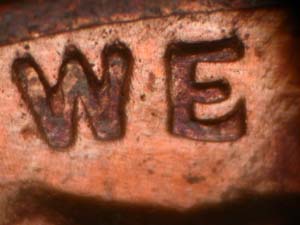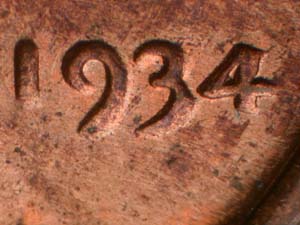
Doubled Dies:
Class VI: Distended Hub Doubling
Distended Hub Doubling
This coin exhibits hub doubling that occurred as a result of the raised images on the hub becoming flattened and thicker than normal. When one normal hub is impressed into the die, and then is followed by a flattened hub, the resulting image is much thicker than normal. On extreme examples, you can see notching of the serifs. However, normally all that can be seen is extra thickness to the letters and digits. Being able to quickly detect this kind of hub doubling requires a firm mental image of what a normal design looks like. Key indicators are sway backs to the letters B, E, and R. This is a very common class of hub doubling, especially on the Lincoln cent where many, many dies are produced each year.
WE Date Notice how the doubling has flattened the design making it look thicker and distended.
Date
Denomination Description
1909 1c DDO-002; 2-O-VI 1934 1c DDO-002; 2-O-VI 1934 1c DDR-004; 4-R-VI 1934-D 1c DDO-001; 1-O-VI 1934-D 1c DDR-001; 1-R-VI 1943 1c DDO-001; 1-O-VI
1945-D 5c DDO-006; 6-O-VI
1954 10c DDO-001; PR-1-O-VI 1953-S 25c DDO-001; 1-O-VI 1946-S 50c DDR-001; 1-R-VI 1973-S $1 DDO-003; 3-O-II-C+VI (4)
| Home |
Introduction |
Design Changes |
Mintmark Styles |
Doubled Dies |
Mintmark Varieties |
RPDs and MPDs |
Die Errors |
| About CONECA |
About the Author |
Copyright James Wiles, 2011
Email: jameswiles@sbcglobal.net
1490 Trail View Lane
Frisco, TX 75034-2649

